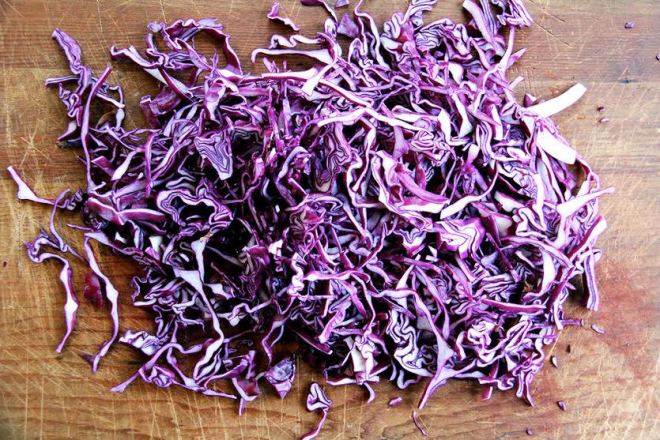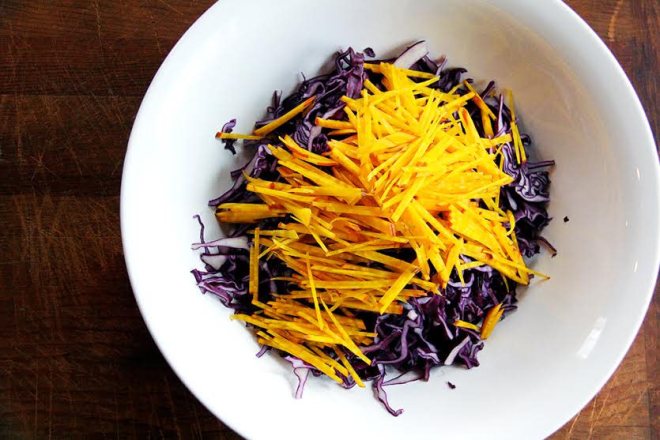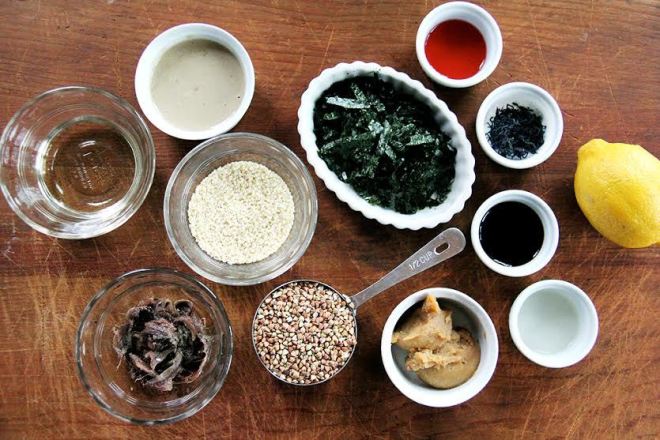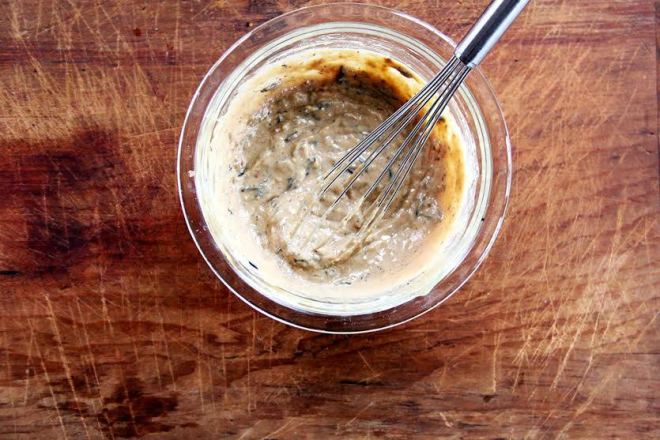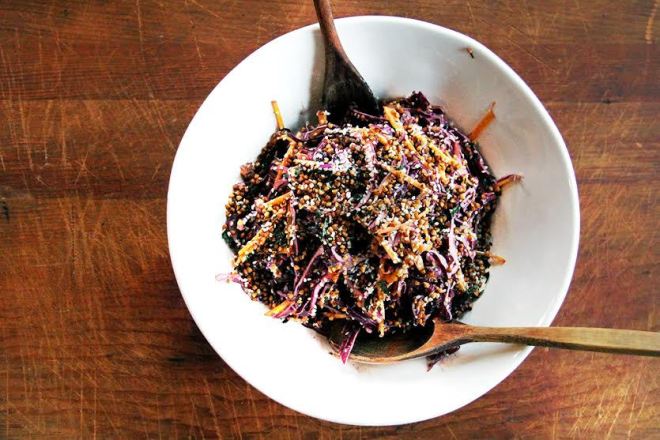I have my husband’s grandmother Violet to thank for introducing me to my favorite holiday side dish: Danish red cabbage, which is a mix of vinegar, sugar, lots of butter, a jar of red currant jelly, and two heads of chopped red cabbage. I’ve never seen Violet make it, but I’ve heard that when she does, she tends to it all day, dipping a fork into her Dutch oven often to taste and adjust and season. Apparently, no one in the family makes it as well as Violet.
Every year in the weeks leading up to Thanksgiving, I look forward to pulling out her hand-written recipe card and attempting to replicate this old family standby. I love it so much, in fact, that I associate red cabbage with only this dish. And as soon as the holidays pass, I don’t want to think about any other cabbage preparation besides this one, the following fall.
So when heads of purple cabbage show up in my CSA box, I struggle to put them to use, often shoving them in the vegetable bin where they sit for weeks until I shred them into a slaw or roast them in wedges. Both are preparations that always leave me wanting.
Red cabbage is coarser than green and, especially when served raw, needs a little more attention, more seasoning, and a bright, sharp dressing to draw out its sweetness. The one in Mission Chinese Food’s cabbage salad is just the thing. The first time I looked at the recipe, in addition to feeling a little overwhelmed by the length and content of the ingredient list, I also thought that it looked promising — lots of acid (two different vinegars and fresh lemon), lots of flavor (miso, tahini, soy sauce, anchovies, and three different types of seaweed), and a variety of texture (cabbage, beets, and kasha, or roasted buckwheat).
At first glance, too, this salad looks like an odd jumble of ingredients, many of which you might not have in your pantry. Don’t let that deter you. Sam Sifton described the combination as “a riot of umami,” and, relaying Mission Chinese Food’s message, encouraged readers not to worry about finding each and every ingredient — any number of vinegars could work in place of the ume and rice vinegars, and using just one of the three seaweeds is just fine. (I was able to find everything I needed with the exception of the shio kombu, which I left out, at my local co-op.)
This salad is at once hearty and fresh, familiar and unusual, and surprisingly addictive. It’s a dish that, even after Violet’s, made me excited for the cabbage in my CSA.
Here’s how to treat the cabbage in your CSA
Purple cabbage should feel firm and heavy with shiny, tight leaves laid against each other. Store it in a cool environment such as your fridge, basement, or garage, and when you’re ready to prep, remove any outer wilted or scraggly leaves. Then, proceed with preparing as your recipe directs. If you’re preparing the cabbage for a raw salad, cut it in half from pole to pole, then remove the triangular-shaped core in each half with a sharp knife. Cooking it instead? If you’re worried about offending anyone with its sulfuric odor, boiling it for a couple of minutes in salted water should remove some of its pungency.
Ideas for putting your cabbage to work
Red cabbage’s firm texture makes it ideal for slaws and salads, where it won’t wilt under a hearty dressing. But as with all cabbages, red cabbage can be braised, steamed, stir-fired, stuffed, or made into sauerkraut.
Raw
Make Fergus Henderson’s tangy, sweet winter salad, or marinate cabbage and kale in a lime vinaigrette and toss with toasted sunflower seeds.
Braised
Use Molly Stevens’ technique and nestle cabbage wedges in a buttered baking dish, cover with foil, braise for two hours adding apples and vinegar halfway, then finish uncovered with red currant jelly until caramelized. Or, braise chopped red cabbage with red wine and red wine vinegar, a pinch of garam masala, roasted beets, tart apples, and sweet carrots.
Sautéed
Make a hearty main course salad: Quickly sauté cabbage, carrots, and fennel, toss with za’atar-spiced roasted chickpeas, and finish with mint, raisins and feta. Or try a bright wintry side dish of sautéed beet greens, red chard, red cabbage, and roasted beets.
Steamed
Make a dumpling filling with shredded cabbage, carrots, and edamame, and a host of herbs, garlic, and ginger. Then stuff the mixture into wontons, steam, and serve with a soy dipping sauce.
Roasted
Toss slices of cabbage and onions with a balsamic dressing, and roast until tender. Top with pears and goat cheese, and continue roasting until melted and caramelized.
Mission Chinese Food’s cabbage salad
See the full recipe and print it here
Serves 4 to 6
1/2 head red cabbage
1 medium beet (yellow or candy-striped is nice)
Juice of 1 lemon
1 teaspoon dried hijiki seaweed
1 teaspoon ume vinegar or red wine vinegar
2 tablespoons sweet white miso paste
3 tablespoons tahini
1 teaspoon unseasoned rice vinegar
1 tablespoon shiro shoyu or light soy sauce
8 anchovy fillets, coarsely chopped
3 tablespoons neutral oil, like canola
1/2 cup kasha
2 tablespoons aonori seaweed, green seaweed, or finely shredded nori
2 tablespoons toasted white sesame seeds
1 tablespoon shio kombu or salted kombu, optional


